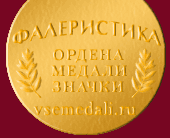Soviet service decorations
Besides orders, there existed quite a number of decorations, ranking close to orders, which were awarded in the name of the Central Executive Committees of the Soviet republics.
In the Azerbaijan SSR, the Proletarian Badge of Honour was instituted in 1920, before the establishment of the republic's Order of the Red Banner. For prominent services to the state, the Badge of Honour of the Azerbaijan SSR was conferred on Nariman Narimanov, Chairman of the Revolutionary Committee of Azerbaijan (subsequently, Chairman of the Council of People's Commissars of Azerbaijan and one of the chairmen of the Central Executive Committee of the USSR), Ali Geidar Karayev, People's Commissar for Military and Naval Affairs of the Azerbaijan SSR (who was also awarded the Order of the Red Banner of the Azerbaijan SSR), A.Nevsky, Chief of the Militia of the City of Baku and the Baku Gubernia, and a number of others.
In Armenia, a badge in the form of a five-pointed silver star adorned with varicoloured enamel was awarded alongside the Order of the Red Banner. In literature, this badge is often referred to as an order. In actual fact, it was a badge of honour awarded in the name of the Central Executive Committee of Armenia or the republic's People's Commissar for Military Affairs.
The History Museum has on show certificate No. 4710, issued to Eligum Ter-Kazaryan in 1921: "This present has been given by the Political Department of the Armenian Infantry Division to Comrade Eligum Ter-Kazaryan to certify that, according to Order No. 297 of November 29,1921, of the People's Commissar for Military Affairs of the Armenian Soviet Socialist Republic, he, being a holder of the Order of the Red Star, has the right to wear the Silver Star presented to him as a gift, which is attested by a signature and a seal. "Eligum Kazaryan's Silver Star of Armenia is on display together with this document in the History Museum's section on numismatics. Here you can also see a silver cigarette holder presented to Ter-Kazaryan with the following inscription in Armenian engraved on it: "A present to the Red hero Eligum Ter-Kazaryan. November 29, 1921, No. 297."
The Silver Star of Armenia was given to active participants in the establishment and defence of Soviet power on the territory of the republic. Evidently, bearers of the Order of the Red Banner of the Armenian SSR were included among those who were to be given this distinction.
In two cases, the awarding of the Silver Star of Armenia - to G.D.Gai and T.Azatyan - was confirmed by orders of the Revolutionary Military Council of the USSR.
In the Russian Federation, the badge of honour "In Commemoration of the Liberation of Soviet Karelia from White Finnish Bands" was instituted in 1922. Between October 1921 and February 1922, armed bands numbering up to 6,000 men and led by White Finnish officers intruded into the territory of the Russian Federation. Supported by local kulaks (well-to-do peasants), they brutally killed Communists, teachers and public servants, plundered the population and destroyed schools and libraries. The small Soviet frontier-guarding units and local detachments headed by Communists could not oppose the White bandits. It was only regular Red Army units, whose operations were directed by Commander-in-Chief of the Armed Forces of the Republic S.S.Kamenev, that put an end to the White Finns' adventure. A detachment of cadets of the Petrograd International Military School Named After the Karelian Labour Commune, commanded by Toivo Antikai-nen, particularly distinguished itself in routing the White raiders. A heroic sally on skis, lasting from January 7 to February 25, 1922, was made against the White Finns to Lake Kimas. Twenty-six participants in the sally, including the commander, were awarded the Order of the Red Banner of the Russian Federation. The order of the Russian Federation was also attached to the banner of the military school. About 70 cadets were presented with watches.
All the participants in the rout of the White Finnish bands were entitled to wear a badge with the inscription "To Honest Soldier of the Karelian Front." This award was entered in the service record and in the service-and-conduct book.
The Bukhara People's Soviet Republic had still another award besides the military order. It is referred to in different documents as the Badge of the Bukhara PSR, the Bukhara Badge of Military Merit, the Badge of Honour of the Bukhara PSR, etc. What is actually meant in all these cases is a metal badge, adorned with varicoloured enamel, which has the inscription "BPSR to Red Fighting Man 1922."
In Yakutia, Soviet power was established through long and persistent struggle. Here the Red heroes who had distinguished themselves most were awarded a special silver badge of honour conferred in the name of the Yakut Autonomous Soviet Socialist Republic.
The Tajik Autonomous Republic (formed in 1924; reorganised into the Tajik Soviet Socialist Republic in 1929) instituted a badge named the Badge of Merit of the TASSR. In most of the cases that we know of, this badge was awarded to those who distinguished themselves in suppressing the basmachi movement.
The background of the badge is formed by a round shield framed in a wreath and laid on two crossed swords. In the centre of the shield is a red five-pointed star with a hammer and a sickle, and a crescent. When receiving the badge, those who were awarded it were also given a printed certificate.
Among the holders of the Badge of Merit of the TASSR were platoon commander Andrei Vedenin (the future Lieutenant-General A.N.Vedenin, Commandant of the Moscow Kremlin), pilot M.T.Slepnyov (who subsequently became one of the first Heroes of the Soviet Union, who were awarded this title for participation in rescuing the crew of the icebreaker Chelyuskin), and others.
|
ПОИСК:
|
При использовании материалов сайта активная ссылка обязательна:
http://vsemedali.ru/ 'Фалеристика — медали, ордена, знаки славы'
